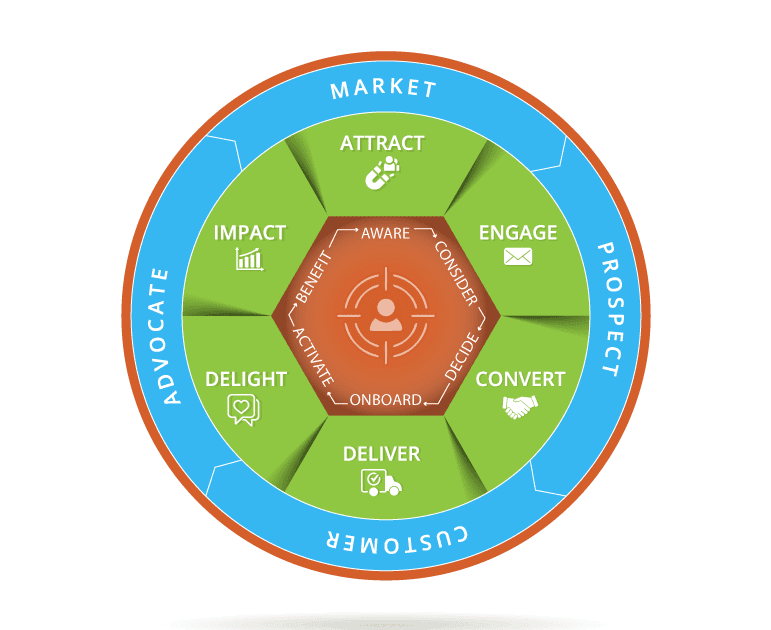
Revenue comes from one place – the customer. Too often, companies don’t fully consider the complete revenue picture when pursuing their revenue growth strategy. This post reinforces the importance of taking an end-to-end customer lifecycle and full-funnel perspective to create and optimize a comprehensive revenue architecture.
The following diagram is an example of a Customer Lifecycle model. It is vital to select the right customers in the right market and convert them into prospects and customers, ultimately building advocacy. This cycle creates a ‘flywheel effect,’ creating value and accelerating revenue performance.
The marketing, sales, and service processes should align with the buying and customer lifecycle. In this example, the customer journey and our marketing and sales process follow six stages:

- Aware Stage. At this stage, the customer confronts a problem or opportunity and searches for and researches potential solutions. In high-consideration products and services, they often form a committee to navigate the research and purchasing process. Our job is to Attract the prospect early in their search and exploration with search-optimized content, events, and experiences that engage buyers to create and qualify leads and opportunities. Our efforts should be prioritized toward attracting the best customers with the greatest potential for lifetime value.
- Consider Stage. Now as they are further along their journey, they begin to narrow their choices. Their interactions may still be largely digital, but they may also connect with influencers, meet with sales teams, and pursue various educational experiences. Our job is to engage prospects with the right mix of digital and physical experiences, using permission marketing principles and collaboratively qualifying mutual fit while providing persona-based educational resources.
- Decide Stage. At this stage, the buyer fully confirms product/service/solution fit and value, engaging directly in the buy-sell process with one or a short list of potential sellers. Our job is to convert new and deepen existing customers at the desired volume and velocity. We apply the right sales process and skills to convert the opportunity into committed business.
- Onboard Stage. In the past, revenue might have been recognized at the sales decision, but today, many businesses have recurring revenue models, and revenue realization is only beginning. Customers may be excited as they anticipate using the product and service. Yet, without proper customer execution, they may lose focus and fail to deploy the solution effectively, introducing potential churn. Our job is to deliver an effective customer experience to onboard our solutions effectively, including the right activation, training, and delivery to maximize satisfaction and foster retention.
- Activate Stage. The customer is now at a critical stage in their process. This may be where the heavy lifting occurs as they need to implement the solution, adopt the service or install the product. They are still not realizing full value yet investing time and energy, creating a temporarily negative value impact. Revenue remains at risk until they realize the expected value from the offering. Our job is to service and delight the customer as they start to activate our solution in their business.
- Benefit Stage. Finally, the customer has fully activated the product or service and is realizing benefits. Revenue is secure when the customer realizes the benefits they expect. Yet, as needs change and companies evolve, our product-market fit may be tested. Retention and revenue risk can increase without a continuous commitment to product/ service value. Our job is to impact value and deliver customer experiences that pave the way for greater LTV, advocacy, and referrals.
By taking a customer-first approach and leveraging the ‘flywheel effect,’ you can drive accelerated, predictable, and sustainable revenue performance. Attracting and engaging the right prospects makes it easier to sell, and customers realize better outcomes and stay longer. They also expand their usage and adoption and become advocates for your brand, driving referrals and awareness.




Leave a Reply
Want to join the discussion?Feel free to contribute!